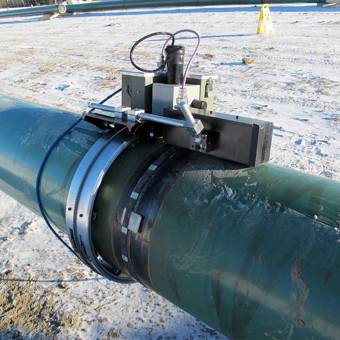Streamline Your Project: Reputable Pipeline Welding Inspection Specialists at Your Solution
Streamline Your Project: Reputable Pipeline Welding Inspection Specialists at Your Solution
Blog Article
Comprehensive Introduction of Pipeline Welding Evaluation Treatments
Pipeline welding examination treatments play a critical function in ensuring that welded connections meet strict market standards and specs. From thorough pre-welding inspections to thorough post-weld assessments, a well-defined assessment process is crucial for preserving the architectural strength of pipes.
Pre-welding Evaluation Preparations
Before starting the welding process, extensive pre-welding inspection prep work are crucial to ensure the integrity and top quality of the weld joint. These preparations entail a thorough evaluation of the products to be welded, the welding devices, and the work atmosphere. By conducting thorough pre-welding assessment preparations, potential problems can be recognized and fixed early on, leading to top quality and reliable weld joints.
Welding Procedure Qualification
Comprehensive pre-welding evaluation prep work lay the structure for the vital process of Welding Treatment Qualification, guaranteeing the stability and high quality of the weld joint. Welding Procedure Certification (WPQ) is an essential action in the welding process that involves screening and licensing welding procedures to guarantee they satisfy details standards and needs. The WPQ process normally includes welding procedure requirements advancement, welding treatment certification testing, and documentation of the results.
Throughout welding treatment requirements advancement, essential details such as the welding process, welding products, joint layout, and welding criteria are defined to create a detailed treatment. Consequently, welding procedure certification screening is conducted to confirm the recommended procedure's integrity. This testing often entails welding test coupons that undergo various mechanical and non-destructive examinations to examine the weld's high quality and adherence to the specified criteria.
In-process Weld Inspection
Throughout the welding process, in-process weld examination plays an important function in guaranteeing the top quality and integrity of the weld joint - Pipeline Welding Inspection. This sort of inspection involves keeping track of the welding parameters, examining the weld grain formation, and finding any kind of potential problems or stoppages as they take place. By carrying out in-process weld assessments, welding drivers can promptly deal with any kind of problems that might develop, thereby ensuring and avoiding more flaws that the last weld meets the needed specifications
Common methods used for in-process weld evaluation include aesthetic inspection, fluid penetrant testing, magnetic particle testing, ultrasonic screening, and radiographic screening. Aesthetic evaluation is often the initial step while doing so, enabling inspectors to visually analyze the weld for surface area abnormalities such as splits, porosity, or insufficient blend. Much more advanced techniques like ultrasonic testing and radiographic testing give comprehensive insights into the inner framework of the weld, making certain that there are no concealed flaws that might compromise link the weld joint's strength and stability. On the whole, in-process weld assessment is crucial for keeping the high quality and reliability of welded pipelines.
Non-destructive Testing (NDT)
Non-destructive Testing (NDT) is an important technique utilized in pipe welding examination to assess the honesty of weld joints without causing damage to the welded structure. By using numerous NDT strategies, inspectors can review the high quality of welds and determine any kind of flaws or interruptions that may jeopardize the structural strength of the pipeline. Typical NDT approaches utilized in pipe welding examination consist of Radiographic Testing (RT), Ultrasonic Screening (UT), Magnetic Particle Testing (MPT), Fluid Penetrant Screening (LPT), and Visual Screening (VT)
RT includes using X-rays or gamma rays to generate photos of the inner framework of the weld, allowing inspectors to identify flaws such as porosity, splits, or insufficient blend. UT makes use of high-frequency audio waves to find flaws beneath the surface area of the weld, providing in-depth information concerning the dimension and area of problems. MPT and LPT are utilized to recognize surface-breaking problems by using penetrant fluids or magnetic fragments to the weld area. Furthermore, VT entails aesthetic evaluation go of welds to identify any kind of noticeable blemishes.
Post-weld Evaluation and Documents


Documents of post-weld examination findings is important for preserving quality assurance documents and making certain compliance with sector criteria and regulations. Comprehensive records ought to consist of information concerning the evaluation approaches used, the area and nature of any kind of issues located, and any rehabilitative actions taken - Pipeline Welding Inspection. Correct documentation not only acts as a document of the weld's top quality however additionally aids in future upkeep and evaluation procedures
Conclusion

To conclude, pipeline welding evaluation treatments play a critical role in guaranteeing the high quality and stability of welds. From pre-welding examinations to post-weld documentation, each action is essential in maintaining the safety and security and effectiveness of pipes. By adhering to established treatments and performing thorough examinations, prospective issues can be determined and addressed prior to they bring about pricey repair services or failures. On the whole, adherence to correct assessment procedures is crucial to the success of pipeline welding tasks.
From thorough pre-welding assessments to detailed post-weld assessments, a well-defined assessment process is important for maintaining the architectural sturdiness of pipelines. By conducting in-process weld evaluations, welding operators can promptly deal with any kind of find out here concerns that might occur, consequently making certain and avoiding more problems that the final weld satisfies the called for requirements.
Usual approaches utilized for in-process weld inspection consist of aesthetic assessment, fluid penetrant testing, magnetic bit screening, ultrasonic testing, and radiographic testing.Non-destructive Testing (NDT) is a critical approach employed in pipe welding inspection to examine the integrity of weld joints without triggering damage to the welded structure. Post-weld inspection includes various methods to assess the welds for defects, including visual evaluation, color penetrant testing, magnetic particle screening, ultrasonic testing, and radiographic screening.
Report this page